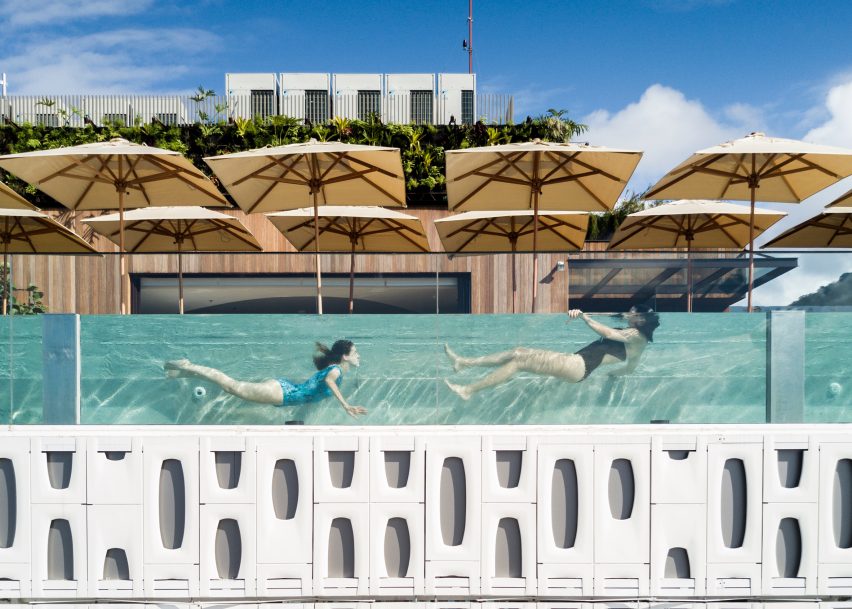Oppenheim Architecture and Studio Arthur Casas have designed this hotel in Rio de Janeiro so that guests can overlook the city's famous Copacabana Beach while bathing in a rooftop swimming pool.
Oppenheim Architecture and Studio Arthur Casas' aim for the Emiliano Hotel was to create a "calm oasis of luxury within the vibrant energy" of the surrounding Copacabana neighbourhood and the lively promenade it fronts, which is home to copious restaurants, bars and nightclubs.
To make the most of beach views, while still maintaining the guests' privacy, the team covered the front of the building with white shutters that are punctured with lozenge-shaped holes.
When opened up entirely, the hinged screens reveal the balconies and large windows of the suites behind, while closing the panels creates a homogenous front that provides shade from the strong Brazilian sun.
"Trying to create a neutral presence on the architecturally cacophonous boulevard, the facade is covered in operable screens that protect from the tropical sun, allowing for custom modulation of space, climate, and privacy," said Oppenheim Architecture.
The hotel's crowning feature is the slender pool with a glazed side, which runs along the top of the building and allows swimmers to look out at the view from underwater. A restaurant behind the pool opens out onto a deck, furnished by sunbathing beds and large umbrellas.
"A rooftop pool with glass edge provides the sensation of floating in the sky above one of the most beautiful places on earth," Oppenheim continued.
The Emiliano Hotel is located along Avenue Atlântica, a major road where an 11-storey apartment building by Zaha Hadid Architects is also under construction, and faces south-east towards the beach.
The other three sides of the hotel are abutted by tall, run-down apartment buildings that date back to the 1950s. In response, the team introduced a pair of patios at the rear of the hotel on the ground floor, which feature glazed roofs and natural vegetation growing up the walls, and allows guests to enjoy outdoors areas without being overlooked.
"Through simple yet powerful spatial manipulations, the hotel is able to optimise its beneficial attributes, while subverting its negative forces," Oppenheim said.
"Guests are able to circulate and inhabit the hotel in total privacy, away from the general public."
The two yards are accessed by large sliding doors. One forms an extension of the restaurant area, and its exterior is wrapped by a long bench that faces dining tables and chairs.
The other adjoins the library, and is furnished by sofas and low-level tables suited to reading, with floors covered in wooden decking. Inside, the walls of the library are lined by a geometric covering that is patterned by cross-shaped lights.
A simple but warm material palette was chosen to decorate the inside. Other communal areas in the hotel include a workspace featuring partitions resembling the perforated facade, wooden chairs with brown leather seats and tall standing lamps. There is also a spa.
Pale terrazzo flooring covers the ground-floor lobby, where a monolithic stone reception deck is set in front of a blue mural. Bedrooms have simple and neutral finishes, like pale parquet flooring, net curtains and white bedding.
Oppenheim Architecture is headquartered in Miami, with other offices in New York and Basel. It was founded in 1999 by Chad Oppenheim, who recently built himself a Bahamas holiday home atop a sandy dune.
A Miami Beach home adapted for tropical living and a quirky renovation of a chalet in Aspen are among other projects completed by the firm.
Photography is by Fernando Guerra.
Project credits:
Architects: Studio Arthur Casas and Oppenheim Architecture (co-author)
Interior design: Studio Arthur Casas
Author: Studio Arthur Casas and Oppenheim Architecture

